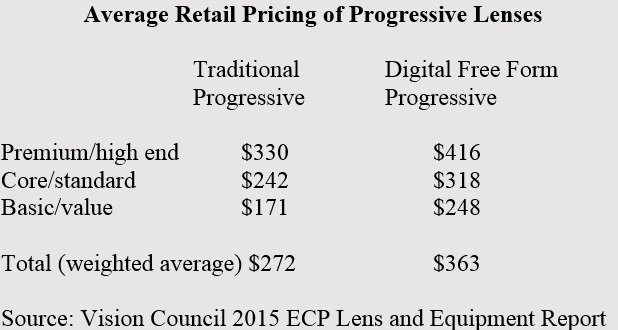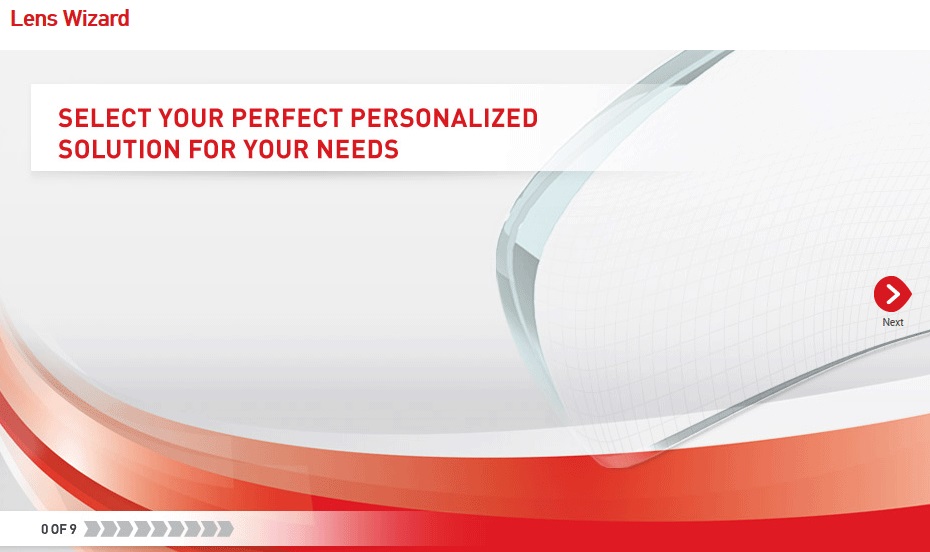Sponsored Content

By Thomas F. Steiner
Nov. 1, 2017
You have the chance to provide better care to patients, while increasing revenues. That opportunity comes in the form of personalized progressive glasses.
In three related articles in this series, Blue Light-Protecting Lenses: Serve Patients, Increase Sales; Increase Second-Pair Sales with Sports Eyewear; and Upgrade Your Eyewear Product Mix with Computer Glasses, it was demonstrated that upgrading the eyewear sales mix offers the highest potential return of any practice improvement initiative that most independent ECPs can undertake.
This is true because prescription eyewear is the dominant revenue source in nearly all practices, usually accounting for more than 40 percent of gross revenue. Eyewear is purchased by 80 percent, or more, of patients, so the opportunities for upgrade are broadly based.
In most practices, the eyewear sales mix has not yet been optimized, and there is substantial revenue growth potential. There is a wide range in the average eyewear sale among independents. This cannot be explained by differences in patient demographics across practices.
According to data from the Management & Business Academy, the 10 percent of practices with the highest average eyewear sale realize revenue per pair 70 percent higher than the median practice, while practices in the bottom 20 percent realize an average eyewear sale 35 percent below the median. Thus, the vast majority of practices have an opportunity to significantly increase their average eyewear sale.
Beyond the immediate financial benefits of improving the sales mix, providing patients with superior eyewear solutions improves their acuity and comfort, which increases satisfaction and loyalty. A practice which offers high-performance technology enhances its reputation among patients and reduces the interval between eyewear purchases.

Click HERE, or the image above, to read how to best sell blue light-protecting lenses. Click HERE to read how to increase second-pair sales with sports glasses. Click HERE to read how to sell more computer glasses.
Personalized Progressive Lens Opportunity
One of the largest eyewear upgrade opportunities that independent ECPs have is personalized progressive lenses. Such lenses appeal to a large share of eyewear buyers, are not worn today by the majority of presbyopes, offer demonstrably superior performance and command high retail prices.
Nearly half of the adult vision corrected population wears multi-focal ophthalmic lenses. According to Vision Watch consumer surveys, multi-focal lenses accounted for 47 percent of total lens sales during the year ending March, 2017–39 million pairs of multi-focal lenses were sold.
Progressive lenses accounted for 65 percent of multi-focal lenses sold over the past twelve months, indicative of a broad level of acceptance of this technology. It is estimated that 76 million adults wear progressive lenses. A practice with 5,000 active patients is likely to have over 2,100 patients wearing progressive lenses.
Based on the Jobson 2017 Premium Lens MarketPulse Survey, personalized progressive lenses currently account for 34 percent of total progressive lens unit sales among eyewear retailers. A 2015 survey of ECPs conducted by the Vision Council indicated that 84 percent of independent ECPs dispensed free-form digital progressive lenses, and 38 percent of total progressive lens unit sales were free-form digital lenses.
The 2017 Jobson study showed that 70 percent of ECPs have increased their usage of personalized progressives over the past three years – a higher percentage of ECPs increasing usage than occurred for other lens types. Despite the growth, most ECPS continue to have considerable upside potential to further increase usage of personalized progressive lenses.
Personalized progressives provide patients a higher level of performance, and thus, represent an opportunity to increase patient satisfaction and loyalty. Dispensing personalized progressives can enhance the practice reputation, identifying it as at the leading edge of technology. Dispensing these lenses also differentiates a practice from commercial and internet providers, who are more likely to promote lower-cost, commodity products requiring little customization.
According to the 2017 Jobson ECP survey, 47 percent of offices currently use a digital measuring device to fit personalized lenses; 17 percent use a floor standing digital measuring device. Such devices visually demonstrate the advanced technology incorporated into these lenses. They also simplify the measurement of vertex distance, pantoscopic tilt and panoramic angle needed to order lenses that are precisely crafted to suit individual patient idiosyncrasies.
Personalized progressive lenses command premium prices. The average retail sale per pair of all ophthalmic lenses is $152, according to Vision Watch consumer surveys. According to the Vision Council’s 2015 ECP Lens and Equipment Report, based on an ECP survey, an average pair of traditional progressive lenses sells for $272.
The average sale of digital free-form progressive lenses is $363, one-third higher than traditional progressives. For premium digital free-form progressive lenses, the average selling price was $416 during 2015, 53 percent higher than for traditional progressive lenses.
An office which currently sells 600 pairs of progressive lenses annually can increase revenue by $10,000, or more, by converting just 100 patients wearing traditional progressives to advanced-technology, personalized progressives.

Steps to Increase Personalized Progressive Lens Sales
Display personalized progressive point-of-sale materials
Many patients remain unaware of the existence of personalized lenses and their benefits. To encourage patient inquiries about these advanced-technology products, and to position the practice as an innovator, post displays and signage about these state-of-the-art products.
Summarize the advantages of personalized progressives
Educate in the exam room, and recommend personalized progressives. To convince patients to purchase personalized progressives they must understand the advantages compared to conventional progressive lenses.
An analogy that patients will understand is the comparison between a suit of clothing that is off-the-rack, and designed for an average person of a given size, versus a custom-fitted suit that takes into account a greater number of variables, and will fit perfectly without compromise.
Only digital measurements of a patient’s characteristics and digital manufacturing makes personalization feasible for eyewear. The benefits to patients include previously unavailable levels of acuity and comfort during the full range of daily vision tasks. After recommending personalized progressives to a patient in the exam room, the doctor should repeat the recommendation as the handoff to the optician is made.
Train staff on benefits and fitting techniques for personalized progressives
Proper fitting of personalized lenses involves measurements not necessary to fit conventional ophthalmic lenses. Opticians must be trained both to take the measurements and to explain to patients how the measurements are incorporated into the final lens design to improve comfort and acuity. This is important to justify the added cost of customization.
Use a digital lens measurement device
Use of a digital measurement device not only improves the accuracy of vital fitting parameters, but communicates the advanced technology involved.
Market Personalized Lenses
Feature personalized progressive lenses in practice newsletters, web site and marketing communications.
Once explained, personalized lenses are recognized by patients as a significant technology advance. As such, they represent excellent topics for presentation in marketing communications.
Shamir: Offer Patients Many Personalized Options
 Thomas F. Steiner, Director of Market Research for ROB, has spent more than 25 years helping eyecare practices succeed, including pioneering the introduction of color contact lenses into optometry. To contact him: tom.steiner@cibavision.com
Thomas F. Steiner, Director of Market Research for ROB, has spent more than 25 years helping eyecare practices succeed, including pioneering the introduction of color contact lenses into optometry. To contact him: tom.steiner@cibavision.com


























